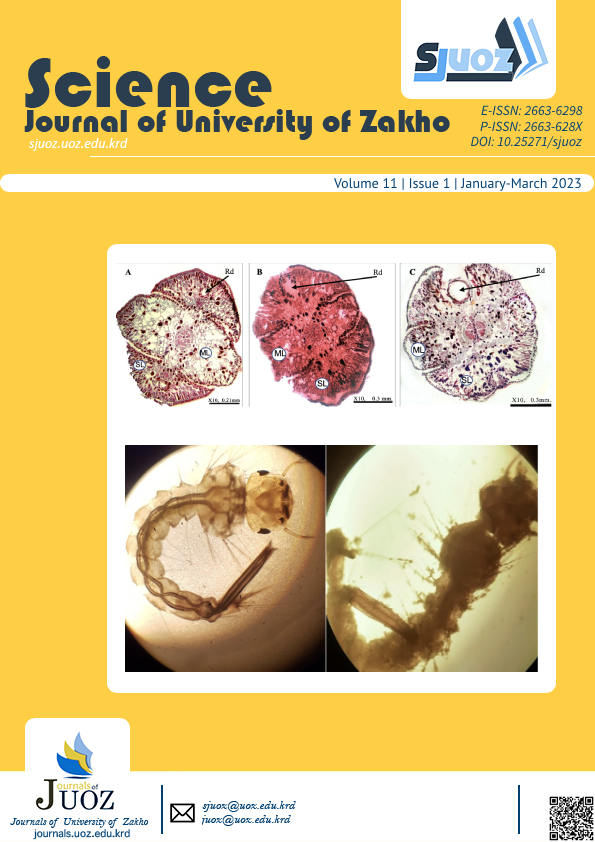Profiling of Bacterial Species from Covid-19 Faecal Samples in Kurdistan Region-Iraq
DOI:
https://doi.org/10.25271/sjuoz.2023.11.1.1031Keywords:
Gut microbiota, COVID-19, 16s RNA gene, SARS-CoV-2, Comamonas kerstersiiAbstract
The invasion of intestinal cells by the severe acute respiratory syndrome coronavirus 2 (SARS-CoV-2) may have an impact on the gut bacteria. This study investigated the alteration of gut bacteria during SARS-CoV-2 viral infection and after recovery. Faecal samples were collected from ten RT-PCR-confirmed COVID-19 patients and five healthy participants (served as a control group) from November 21st, 2021 to April 1st, 2022. The faeces samples were collected three times, at the time of infection, after seven days of the infection and on day fifty after clearance of SARS-CoV-2. Serum samples were used to perform serological tests for the control group and COVID-19 survived patients. Pure culture techniques and classical and molecular approaches were used to isolate and identify the bacterial population in the collected faeces. The faecal bacterial communities of patients with COVID-19, those who recovered, and the five healthy people were compared. Significant alteration in culturable gut bacteria was observed in COVID-19 patients compared to the control group. This alteration was expressed by the existence of four bacterial species, which were Escherichia fergusonii, Citrobacter portucalensis, Comamonas kerstersii, and Shigella flexneri. In addition, two respiratory tract-associated bacterial pathogens, Klebsiella pneumoniae and Klebsiella aerogenes were recovered from the faecal samples of 40% of COVID-19 patients. The results even revealed that Staphylococcus aureus was more prevalent in faeces samples from those with SARS-CoV-2 infections than the healthy individuals. Faecal analysis of COVID-19 patients showed the existence and elevation of pathogenic bacteria in the large intestine in comparison to the healthy group. Further studies are required to highlight how an alteration of gut microbiomes affects the course of COVID-19 infection.
References
Atlas, R. M., Brown, A. E., & Parks, L. C. (1995). Laboratory Manual of Experimental Microbiology. Mosby-Year Book, Inc., U.S.A.
Brestoff, J.R. & Artis, D., (2013). Commensal bacteria at the interface of host metabolism and the immune system. Nature immunology, 14(7), pp.676-684. https://doi.org/10.1038%2Fni.2640
Cappuccino, J. & Welsh, C., (2019). Microbiology: a laboratory manual. 12th ed. New York: Pearson, pp.151:217.
Chakravorty, S., Helb, D., Burday, M., Connell, N., & Alland, D. (2007). A detailed analysis of 16S ribosomal RNA gene segments for the diagnosis of pathogenic bacteria. J Microbiol Methods. May;69(2):330-9. https://doi.org/10.1016/j.mimet.2007.02.005
Chen, N., Zhou, M., Dong, X., Qu, J., Gong, F., Han, Y., Qiu, Y., Wang, J., Liu, Y., Wei, Y. & Yu, T., (2020). Epidemiological and clinical characteristics of 99 cases of 2019 novel coronavirus pneumonia in Wuhan, China: a descriptive study. The lancet, 395(10223), pp.507-513. https://doi.org/10.1016/S0140-6736(20)30211-7
Chen, Y., Gu, S., Chen, Y., Lu, H., Shi, D., Guo, J., Wu, W.R., Yang, Y., Li, Y., Xu, K.J. & Ding, C., (2022). Six-month follow-up of gut microbiota richness in patients with COVID-19. Gut, 71(1), pp.222-225 http://dx.doi.org/10.1136/gutjnl-2021-324090
Cheung, K.S., Hung, I.F., Chan, P.P., Lung, K.C., Tso, E., Liu, R., Ng, Y.Y., Chu, M.Y., Chung, T.W., Tam, A.R. & Yip, C.C., (2020). Gastrointestinal manifestations of SARS-CoV-2 infection and virus load in fecal samples from a Hong Kong cohort: systematic review and meta-analysis. Gastroenterology, 159(1), pp.81-95. https://doi.org/10.1053/j.gastro.2020.03.065
Covasa, M., Stephens, R.W., Toderean, R. & Cobuz, C., (2019). Intestinal sensing by gut microbiota: targeting gut peptides. Frontiers in endocrinology, 10, p.82. https://doi.org/10.3389/fendo.2019.00082
Fan, Y. & Pedersen, O., (2020). Gut microbiota in human metabolic health and disease. Nature Reviews Microbiology, pp.1-17. https://doi.org/10.1038/s41579-020-0433-9
Fanos, V., Pintus, M. C., Pintus, R., & Marcialis, M. A. (2020). Lung microbiota in the acute respiratory disease: from coronavirus to metabolomics. Journal of Pediatric and Neonatal Individualized Medicine (JPNIM), 9(1), e090139-e090139. https://doi.org/10.7363/090139
Gerhardt, P., Murray, R.G.E., Costilow, R.N., Nester, E.W., Wood, W.A., Krieg, N.R. & Phillips, G.B., (1981). Manual of methods for general bacteriology.
Groves, H.T., Cuthbertson, L., James, P., Moffatt, M.F., Cox, M.J. & Tregoning, J.S., (2018). Respiratory disease following viral lung infection alters the murine gut microbiota. Frontiers in immunology, 9, p.182 https://doi.org/10.3389/fimmu.2018.00182
Gu, J., Gong, E., Zhang, B., Zheng, J., Gao, Z., Zhong, Y., ... & Leong, A. S. Y. (2005). Multiple organ infection and the pathogenesis of SARS. The Journal of experimental medicine, 202(3), 415-424. http://www.jem.org/cgi/doi/10.1084/jem.20050828
Gu, S., Chen, Y., Wu, Z., Chen, Y., Gao, H., Lv, L., Guo, F., Zhang, X., Luo, R., Huang, C. & Lu, H., (2020). Alterations of the gut microbiota in patients with coronavirus disease 2019 or H1N1 influenza. Clinical Infectious Diseases, 71(10), pp.2669-2678. https://doi.org/10.1093/cid/ciaa709
Hanada, S., Pirzadeh, M., Carver, K. Y., & Deng, J. C. (2018). Respiratory viral infection-induced microbiome alterations and secondary bacterial pneumonia. Frontiers in immunology, 9, 2640. https://doi.org/10.3389/fimmu.2018.02640
Huang, C., Wang, Y., Li, X., Ren, L., Zhao, J., Hu, Y., Zhang, L., Fan, G., Xu, J., Gu, X. & Cheng, Z., (2020). Clinical features of patients infected with 2019 novel coronavirus in Wuhan, China. The lancet, 395(10223), pp.497-506. https://doi.org/10.1016%2FS0140-6736(20)30183-5
Kho, Z.Y. & Lal, S.K., (2018). The human gut microbiome–a potential controller of wellness and disease. Frontiers in microbiology, 9, p.1835. https://doi.org/10.3389/fmicb.2018.01835
Liang, W., Feng, Z., Rao, S., Xiao, C., Xue, X., Lin, Z., Zhang, Q. & Qi, W., (2020). Diarrhoea may be underestimated: a missing link in 2019 novel coronavirus. Gut, 69(6), pp.1141-1143. http://dx.doi.org/10.1136/gutjnl-2020-320832
Liu, Q., Mak, J. W. Y., Su, Q., Yeoh, Y. K., Lui, G. C. Y., Ng, S. S. S., ... & Ng, S. C. (2022). Gut microbiota dynamics in a prospective cohort of patients with post-acute COVID-19 syndrome. Gut, 71(3), 544-552. http://dx.doi.org/10.1136/gutjnl-2021-325989
Murray, P.R., Baron, E.J., Jorgensen, J.H., Landry, M.L. & Pfaller, M.A., (2006). Manual of clinical microbiology: Volume 1 (No. Ed. 9). ASM press Washington USA.
Ogunrinola, G. A., Oyewale, J. O., Oshamika, O. O., & Olasehinde, G. I. (2020). The Human Microbiome and Its Impacts on Health. International journal of microbiology, 2020, 8045646. https://doi.org/10.1155/2020/8045646
Rhoads, D. D., Cox, S. B., Rees, E. J., Sun, Y., & Wolcott, R. D. (2012). Clinical identification of bacteria in human chronic wound infections: culturing vs. 16S ribosomal DNA sequencing. BMC Infectious Diseases, 12(1), 1-8. https://doi.org/10.1186/1471-2334-12-321
Robinson, C.J., Bohannan, B.J. & Young, V.B., (2010). From structure to function: the ecology of host-associated microbial communities. Microbiology and Molecular Biology Reviews, 74(3), pp.453-476. https://doi.org/10.1128%2FMMBR.00014-10
Smith, A.C. & Hussey, M.A., (2005). Gram stain protocols. American Society for Microbiology, 1, p.14.
Wang, B., Yao, M., Lv, L., Ling, Z. & Li, L., (2017). The human microbiota in health and disease. Engineering, 3(1), pp.71-82. https://doi.org/10.1016/J.ENG.2017.01.008
Wang, J., Li, F., Wei, H., Lian, Z. X., Sun, R., & Tian, Z. (2014). Respiratory influenza virus infection induces intestinal immune injury via microbiota-mediated Th17 cell–dependent inflammation. Journal of Experimental Medicine, 211(12), 2397-2410. https://doi.org/10.1084/jem.20140625
Whiteside, S.A., Razvi, H., Dave, S., Reid, G. & Burton, J.P., (2015). The microbiome of the urinary tract—a role beyond infection. Nature Reviews Urology, 12(2), p.81 http://www.nature.com/doifinder/10.1038/nrurol.2014.361
Wölfel, R., Corman, V.M., Guggemos, W., Seilmaier, M., Zange, S., Müller, M.A., Niemeyer, D., Jones, T.C., Vollmar, P., Rothe, C. & Hoelscher, M., (2020). Virological assessment of hospitalized patients with COVID-2019. Nature, 581(7809), pp.465-469. https://doi.org/10.1038/s41586-020-2196-x
Yildiz, S., Mazel-Sanchez, B., Kandasamy, M., Manicassamy, B. & Schmolke, M., (2018). Influenza A virus infection impacts systemic microbiota dynamics and causes quantitative enteric dysbiosis. Microbiome, 6(1), pp.1-17. https://doi.org/10.1186/s40168-017-0386-z
YOON, S.-H., HA, S.-M., KWON, S., LIM, J., KIM, Y., SEO, H. & CHUN, J. (2017). Introducing EzBioCloud: a taxonomically united database of 16S rRNA gene sequences and whole-genome assemblies. International journal of systematic and evolutionary microbiology, 67(5): 1613-1617. https://doi.org/10.1099%2Fijsem.0.001755
Zuo, T., Zhang, F., Lui, G.C., Yeoh, Y.K., Li, A.Y., Zhan, H., Wan, Y., Chung, A.C., Cheung, C.P., Chen, N. & Lai, C.K., (2020). Alterations in gut microbiota of patients with COVID-19 during time of hospitalization. Gastroenterology, 159(3), pp.944-955. https://doi.org/10.1053/j.gastro.2020.05.048
Published
How to Cite
Issue
Section
License
Copyright (c) 2023 Mohammed A. Hama-Ali, Ayad H. Hasan

This work is licensed under a Creative Commons Attribution 4.0 International License.
Authors who publish with this journal agree to the following terms:
- Authors retain copyright and grant the journal right of first publication with the work simultaneously licensed under a Creative Commons Attribution License [CC BY-NC-SA 4.0] that allows others to share the work with an acknowledgment of the work's authorship and initial publication in this journal.
- Authors are able to enter into separate, additional contractual arrangements for the non-exclusive distribution of the journal's published version of the work, with an acknowledgment of its initial publication in this journal.
- Authors are permitted and encouraged to post their work online.












